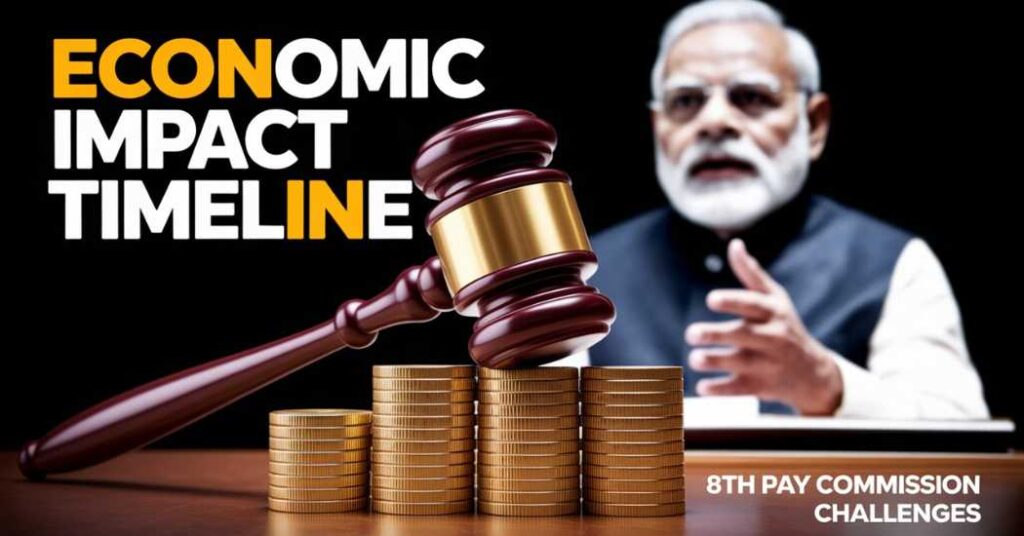8th Pay Commission Challenges 2025: Economic Impact, Timeline, and More.
The 8th Pay Commission’s recommendations are poised to have a significant impact, not only on government employees but also on India’s broader economic landscape. These changes will affect the way government compensation is structured, leading to a ripple effect across both central and state governments. In this article, we will examine the economic implications, expected timeline for implementation, and potential challenges the Commission may face.
8th Pay Commission Challenges on State Government Employees
Although primarily designed for central government employees, the 8th Pay Commission’s recommendations often set the stage for similar reforms at the state level. Typically, state governments adopt the central guidelines, but the degree to which they implement them can vary based on their financial condition.
For state government employees, the adoption of the revised pay scales and allowances could result in salary hikes and updated pension schemes. However, states with tighter budgets might struggle to fully implement the Commission’s recommendations immediately. As such, the timeline for pay revisions may vary from state to state, with some states gradually rolling out changes over time.
Expected Timeline and Implementation
The implementation timeline of the 8th Pay Commission is crucial for employees eagerly anticipating changes to their compensation. Historically, the recommendations of previous pay commissions, such as the 7th Pay Commission, have been implemented after several years of deliberation. The 7th Pay Commission, for instance, was constituted in 2014, and its suggestions were implemented by 2016, although there were some delays.
For the 8th Pay Commission, it is anticipated that the recommendations will be submitted within 12 to 24 months of its formation, with the revised pay structure potentially being rolled out 18 to 24 months thereafter. However, this timeline could be influenced by various factors, such as government priorities, budget allocations, and the complexity of the proposed changes. Additionally, there may be delays between the announcement of the revised pay scales and their actual implementation, particularly when new allowances and benefits are introduced.
Also Read: 8th Pay Commission Affects Salary – April 2025: All Real Facts
Some regions, particularly less developed areas, might face challenges in swiftly adopting these changes due to administrative issues. While the central government might implement these updates faster, state and local governments could need more time to adjust.
8th Pay Commission Challenges on Economical Implications and Fiscal Issues
The economic implications of implementing the 8th Pay Commission’s recommendations are substantial, particularly with regard to the government’s fiscal policies. The proposed salary increases and revised allowances are expected to place a significant financial burden on both central and state governments. The overall cost of these changes could run into several lakh crores over time.

At the central government level, the rise in compensation will impact the annual budget, requiring a reallocation of funds. In order to accommodate these increases, the government might need to reduce spending in other non-essential areas or scale back existing welfare programs. Similarly, state governments will need to assess their financial capacity to absorb these additional costs, potentially leading to fiscal constraints and budget adjustments.
While these pay revisions are necessary to ensure that government employees remain motivated and adequately compensated, they could also contribute to inflationary pressures, particularly if the cost of these adjustments is passed on to consumers in the form of higher taxes or increased prices for goods and services.
8th Pay Commission Challenges and Criticisms
Like any pay commission, the 8th Pay Commission’s recommendations are likely to face challenges and criticisms. A primary concern is the financial burden posed by the proposed salary hikes and allowances, which could increase fiscal deficits and lead to higher borrowing. These fiscal strains could have long-term economic consequences.
Additionally, some employees may feel that the pay increments do not adequately reflect their responsibilities. While lower and middle-level employees may benefit from the salary hikes, those in higher positions could argue that their compensation does not match their expertise and responsibilities. Trade unions representing government workers may also push for higher salary increases, citing the current economic conditions as justification for more substantial revisions.
Another point of criticism could be the adequacy of the recommendations in addressing disparities between different government sectors. For example, employees in administrative roles might feel that their challenges differ significantly from those in sectors like healthcare, education, or public safety. The Commission’s suggestions may not fully address these sector-specific needs, leading to resistance from various groups.
Finally, the implementation timeline itself could come under scrutiny. Delays in disbursing revised salaries and allowances could cause dissatisfaction among employees who expect timely compensation adjustments. Furthermore, the bureaucratic hurdles involved in implementing large-scale reforms may add to the frustration, particularly if the changes take longer than expected to be realized.
Conclusion
The 8th Pay Commission’s recommendations will play a crucial role in shaping the future of government compensation in India. While the proposed changes are expected to benefit government employees, they also present significant economic challenges that require careful financial planning. The successful implementation of these recommendations will depend on the government’s ability to balance fair compensation with fiscal responsibility, ensuring that the reforms do not strain the economy in the long term. As the timeline for implementation unfolds, it will be important to address the concerns and criticisms surrounding the recommendations to ensure smooth execution and widespread satisfaction.








